Diversity in Living Organisms Summary Class 9 Science
Introduction
- All living organism are grouped on the basis of their similarities and increasing complexities into different complexities.
- Biodiversity means the variety of living organisms present on a particular region.
- There are about 20 lac organisms known on the earth which differ from one another in external form, internal structure, mode of nutrition, habitat, etc.
Taxonomy: It is a branch of biology which deals with identification, nomenclature and classification of organisms. Carolus Lannaeus is called the father of taxonomy.
Classification
- The method of arranging organisms into groups or sets on the basis of similarities and differences is called classification.
Importance of Classification
- It makes the study of wide variety of organisms easy and in systematic manner.
- It helps to understand how the different organisms have evolved with time.
- It helps to understand the inter-relationships among different groups of organisms.
- It forms a base for the study of other biological sciences, like biogeography.
Basis of Classification
- There are certain features or properties used for the classification of living organisms which are known as characteristics.
- Organisms with same characteristics are placed in same groups.
Classification System
- Two kingdom classification: Carolus Linnaeus in 1758 classified the living organisms into two groups as plants and animals.
- Five kingdom classification: H. Whittaker in 1959 further classified the organisms into five kingdoms as Kingdom Monera, Kingdom Protista, Kingdom Fungi, Kingdom Plantae and Kingdom Animalia.
- Carl Woese in 1977 further divided Kingdom Monera into archaebacteria (or Archae) and Eubacteria (or Bacteria).
- Hierarchy of Classification: Linnaeus proposed a classification system by arranging organisms into taxonomic groups at different levels according to the characteristics they have.
Groups or Levels from Top to Bottom
- The major characteristics considered for classifying all organisms into five major kingdoms.
Type of cellular organization
- Prokaryotic cells: These are primitive and incomplete cells without well-defined nucleus.
- Eukaryotic cells: These are advanced and complete cells with well-defined nucleus.
Body organization
- Unicellular organisms: These are organisms made up of single cell with all activities performed by the single cell.
- Multicellular organisms: These are organisms made up of large number of cells with different functions performed by different cells.
Mode of obtaining food
- Autotrophs: These are the organisms that make their own food by photosynthesis.
- Heterotrophs: These are the organisms which depend on other organisms for food.
Five Kingdom Classification
R. H. Whittaker taxonomist was the first one to propose five kingdom classification.
Monera
- Type: Unicellular Prokaryotic
- Mode of nutrition: Autotrophic or heterotrophic
- Body: Lack well-defined nucleus and cell organelles
Examples: Bacteria, Blue-green algae
Protista
- Type: Unicellular Eukaryotic
- Mode of nutrition: Autotrophic or Heterotrophic
- Body: Some organisms use pseudopodia or cilia or flagella for movement
Examples: Amoeba, Paramecium, Euglena
Fungi
- Type: Multicellular Non-green Eukaryotic
- Mode of nutrition: Saprophytic or Parasitic Sometimes symbiotic
- Body: Fungus is made up of long filaments called hyphae. The network of hyphae is mycelium.
Examples: Yeast, Rhiozpus, Mushrooms moulds
Plantae
- Type: Multicellular Eukaryotic
- Mode of nutrition: Autotrophic
- Body: Exhibits high level of tissue differentiation and have specialized body organs.
Examples: Trees, Plants, Shrubs
Animalia
- Type: Multicellular Eukaryotic
- Mode of nutrition: Heterotrophic
- Body: Exhibits high level of tissue differentiation and have specialized body organs. They have well developed nervous system.
Examples: Fish, Insects, Animals, Humans, Birds
Kingdom I: Monera
- Prokaryotic, unicellular.
- Can be autotrophs or heterotrophs.
- May or may not have cell wall.
Examples: Anabaena and Bacteria (heterotrophic), Cyano-bacteria or Blue-green algae (autotrophic).
Kingdom II: Protista
- Eukaryotic, unicellular.
- Can be autotrophic or heterotrophic.
- May have cilia, flagella or pseudophodia for locomotion.
Examples: Plants like unicellular algae, diatoms; animals like protozoans (Amoeba, Paramecium, Euglena); fungi like slime molds and water molds.
Kingdom III: Fungi
- Eukaryotic.
- Mostly multicellular but sometimes unicellular (yeast).
- Source of food:
- Mostly saprophytes: These organisms use decaying material for food.
- Some parasitic: These organisms live inside body of other living organism to have food and can be disease causing.
- Symbiotic relation: These are relations between two organisms in which they live together for benefit of one or both.
(i) Lichens are a symbiotic relation between fungi and cyanobacteria.
(ii) Here fungi gets food from cyanobacteria and in return cyanobacteria gets water and protection from sunlight through fungi.
- Cell wall is made of chitin.
- Examples: Mushrooms (Agaricus), green mold (Penicillium), smut (Aspergilus).
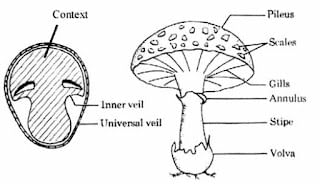
Kingdom IV: Plantae
- Eukaryotic, multicellular.
- Autotrophs.
- Cell wall present.
Basis of division in Kingdom Plantae
- Differentiated body parts: Body is differentiated into leaves, stems, roots, flowers, etc.
- Presence of vascular tissue: There are two types of vascular tissues present in the plants.
- Xylem: Helps in transport of water.
- Phloem: Helps in transport of food.
- Reproduction through seeds or spores:
- Phanerogamae: Plants with seeds are called phanerogamae. They contains embryo with stored food and are multicellular.
- Cryotogamae: Plants with spores are called cryptogamae. They contains only naked embryo and are generally unicellular.
- Seeds are inside the fruit or naked:
- Angiospermae: These are plants with seeds inside the fruit and bears flowers.
- Gymnospermae: These are plants with naked seeds and do not bear flowers.
Division 1: Thallophyta
- Basic and elementary plants with undifferentiated body parts.
- Generally called algae.
- No vascular tissue present.
- Reproduce through spores.
- Mainly found in water.
Example: Ulva, Spirogyra, Ulothrix, Cladophora, Chara.
Division 2: Bryophyte
- Body structure differentiated but not fully developed.
- No vascular tissues present.
- Reproduce through spores.
- Found on both land and water therefore known as ‘Amphibians of Plantae Kingdom’.
Example: Liverwort (Marchantia, Riccia), Mosses (Funaria), Hornwort (Dendrocerous).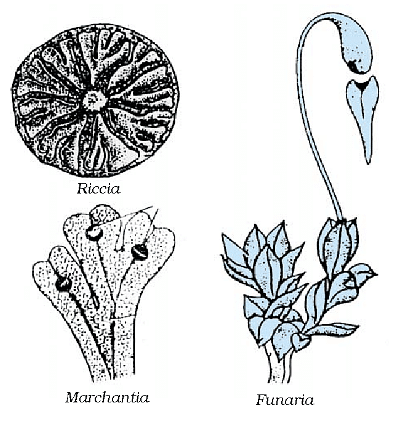
Division 3: Pteridophyta
- Differentiated body structure – leaves, stems, roots, etc.
- Vascular tissues present.
- Reproduce through spores.
Examples: Marsilea, fern, horsetails.
Division 4: Gymnosperms
- Differentiated body parts.
- Vascular tissues.
- Naked seeds without fruits or flowers.
- Perennial, evergreen and woody.
Examples : Pines (deodar), Cycus, Ginkgo.
Division 5: Angiosperms
- Also known as flower-bearing plants.
- Later on flower becomes fruit.
- Seeds are inside the fruit.
- Embryos in seeds have structure called cotyledons. They are also called seed leaves because in many plants they emerge and become green when they germinate.


Angiosperms are further divided on the basis of number of cotyledons into two parts i.e. Monocots and Dicots.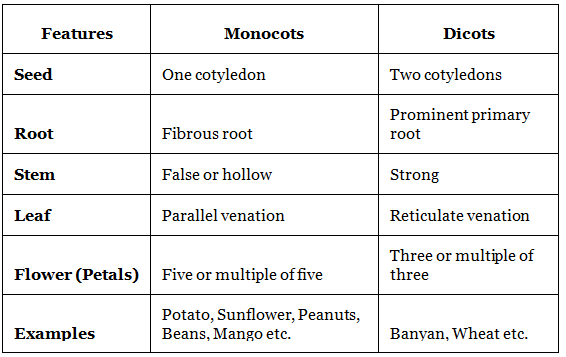
Kingdom V: Animalia
- Basis of classification of Animalia kingdom:
Symmetry
- Bilateral symmetry: It is when an organism can be divided into right and left halves, identical but mirror images, by a single vertical plane.
- Radial symmetry: It is when an organism is equally spaced around a central point, like spokes on a bicycle wheel.
Germ layers
- In embryonic stages there are different layers of cells called germ cells.
The three different types of germ cells are:
- Ectoderm: It is the outermost layer which forms nail, hair, epidermis, etc.
- Endoderm: It is the innermost layer which forms stomach, colon, urinary, bladder, etc.
- Mesoderm: It is the middle layer between ectoderm and endoderm which forms bones, cartilage, etc.
According to the number of germ layers present in embryonic stage, animal could be:
- Diploblastic: Organisms which are derived from two embryonic germ layers (ecto and endo).
- Triploblastic: Organisms which are derived from all the three embryonic germ layers.
Coelom
- Body cavity or coelom is important for proper functioning of various organs.
For example, heart which has to contract and expand needs some cavity or empty space, which is provided by the coelom.
On the basis of presence or absence of coelom, organisms are divided into:
- Acoelomates: These are the simple organisms having no body cavity.
- Coelomates: These are complex organisms having true cavity lined by mesoderm from all sides.
- These are further sub-divided into schizocoelomates or protostomes (coelom formed due to splitting or mesoderm) and enterocoelomates or dueterostomes (coelom formed from pouches pinched off from endoderm).
- Pseudo coelamate: These are organisms having false coelom. They have pouches of mesoderm scattered between endoderm and ectoderm.
Notochord
It is a long rod like structure, which runs along the body between nervous tissues and gut and provides place muscle to attach for ease of movement.
Organisms could be:
- without notochord
- with notochord
- with notochord in initial embryonic stages and vertebral column in adult phase.
Phylum 1: Porifera or Sponges
- Cellular level of organization
- Non-motile animals
- Holes on body which led to a canal system for circulation of water and food
- Hard outside layer called as skeletons
Examples: Sycon, spongilla, euplectelia
Phylum 2: Coelenterata
- Tissue level of organization
- No coelom
- Radial symmetry, diploblastic
- Hollow gut
- Can move from one place to another
Examples: Hydra, sea anemone, jelly fish (solitary), corals (colonies)
Phylum 3: Platyhelminthes
- Also called flat worms
- No coelom present
- Bilateral symmetry, triploblastic
- Free living or parasite
- Digestive cavity has one opening for both ingestion and egestion
Examples: Planaria (free living), liver fluke (parasitic)
Phylum 4: Mollusca
- Coelom present
- Triploblastic, bilateral symmetry
- Soft bodies sometimes covered with shell
- Generally not segmented
- No appendages present
- Muscular foot for movement
- Shell is present
- Kidney like organ for excretion
Examples: Chiton, octopus, pila, unio
Phylum 5: Annelida
- Second largest phylum
- Coelom present
- Bilateral, triploblastic
- Segmented (segments specialized for different functions)
- Water or land
- Extensive organ differentiation
Examples: Earthworm, leech, nereis
Phylum 6: Arthropoda
- Largest phylum (consist of 80% of species)
- Generally known as insects
- Coelom present
- Bilateral, triploblastic
- Segmented, sometimes fused
- Tough exo-skeleton of chitin
- Joing appendages like feet, antenna
Examples: Prawn, scorpio, cockroach, housefly, butterfly, spider
Phylum 7: Echinodermata
- Spiny skin, marine
- No notochord
- Coelom present, bilateral symmetry, triploblastic
- Endoskeleton of calcium carbonate
- Water vascular system for locomotion
- Bilateral symmetry before birth and radial symmetry after birth
Examples : Antedon, sea cucumber, star fish, echinus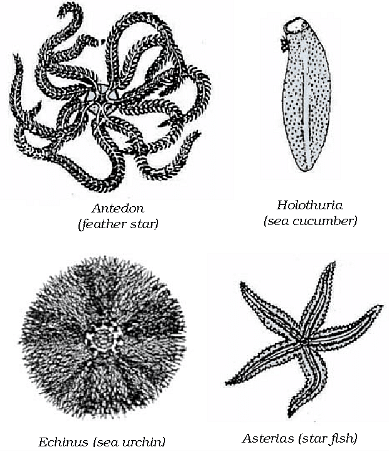
Phylum 8: Protochordata
- Marine animals.
- Bilaterally symmetrical, triploblastic and have a coelom.
- Gills present at some phase of life
- Notochord is present which is a long rod-like support structure (chord=string) that runs along the back of the animal separating the nervous tissue from the gut.
- Notochord provides a place for muscles to attach for ease of movement.
Examples: Balanoglossus, Herdmania and Amphioxus
Phylum 9: Nematoda
- Bilaterally symmetrical and triploblastic.
- Body is cylindrical rather than flattened.
- Tissues, but no real organs.
- Sort of body cavity or a pseudocoelom, is present.
- Familiar as parasitic worms causing diseases.
- Worms causing elephantiasis (filarial worms) or the worms in the intestines (roundworm or pinworms).
Examples: Ascaris, Wuchereria
Phylum 10: Vertebrata
- Notochord converted to vertebral column
- 2, 3, 4 chambered heart
- Organs like kidney for excretion
- Pair appendages
Examples: Humans (4-chambered), frog (3-chambered), fishes (2-chambered)
Vertebrates are divided into five classes namely Pisces, Amphibia, Reptilia, Aves and Mammalia.
- Warm blooded organisms: These are organisms which maintain same body temperature irrespective of outside temperature.
Example: Humans. Human’s body temperature is approximately 37º. - Cold blooded organisms: These are organisms which change their body temperature as per surrounding temperature.
Example : Frog.
Pisces (Fishes)
- They are fishes living in water.
- Their skin is covered with scales or plates.
- They respire using gills.
- They have streamlined body and fins which help them to move in water.
- They are cold blooded and their heart has only two chambers.
- They lay eggs from which the young ones hatch out.
Fishes are divided into two categories on the basis of skeleton:
- Fishes with cartilage skeleton called cartilaginous fishes. Example : Shark, Rays etc.
- Fishes with bony skeleton called bony fishes. Example : Tuna, Rohu etc.
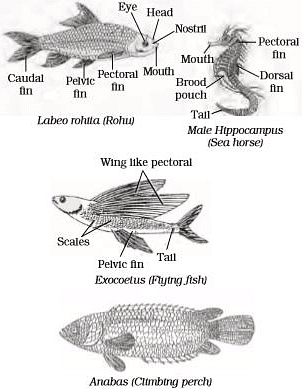
Amphibia (Amphibians)
- They are found in land and water.
- They do not have scales but have mucous glands on their skin.
- They are cold blooded and the heart is three chambered.
- Respiration is through gills or lungs. They lay eggs in water.
Example: Frogs, Toads, Salamanders etc.
Reptilia (Reptiles)
- They have scales and breathe through lungs.
- They are cold blooded.
- Most of them have three chambered heart but crocodiles have four chambered heart.
- They lay eggs with hard covering in water.
Example: Snakes, Turtles, Lizards, Crocodiles etc.
Aves (Birds)
- They are warm blooded animals.
- They have four chambered heart.
- They breathe through lungs.
- They have an outer covering of feathers.
- Their two fore limbs are modified into wings for flying. They lay eggs.
Example: Crow, Sparrow, Pigeon, Duck, Stork, Ostrich etc.
Mammalia (Mammals)
- They are warm blooded animals.
- They have four chambered heart.
- They have mammary glands for production of milk to nourish their young ones.
- The skin has hairs and sweat glands. Most of them give birth to their young ones.
- Some of them lay eggs (like Platypus and Echidna).
Example: Cat, Rat, Dog, Lion, Tiger, Whale, Bat, Humans etc.
Nomenclature
- An organism can have different names in different languages. This creates confusion in naming organism.
- A scientific name is needed which is same in all languages.
- Binomial nomenclature system given by Carolus Linnaeus is used naming different organisms.
Some conventions in writing the scientific names:
- Genus should be written followed by the species.
- First letter of the genus should be capital and that of the species should be in small letter.
- When printed the name should be written in italics and when written with hands genus and species should underlined separately.
Example: Homo sapiens for humans, Panthera tigris for tiger.
|
494 videos|387 docs
|
















